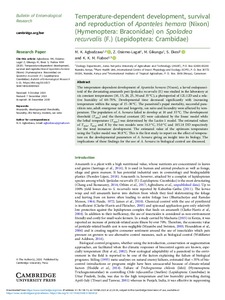| dc.contributor.author | Agbodzavu, M.K. |
| dc.contributor.author | Osiemo-Lagat, Z. |
| dc.contributor.author | Gikungu, M. |
| dc.contributor.author | Ekesi, S. |
| dc.contributor.author | Fiaboe, K. |
| dc.date.accessioned | 2020-05-21T09:37:38Z |
| dc.date.available | 2020-05-21T09:37:38Z |
| dc.date.issued | 2020-02-18 |
| dc.identifier.citation | Agbodzavu, M.K., Osiemo-Lagat, Z., Gikungu, M., Ekesi, S. & Fiaboe, K. (2020). Temperature-dependent development, survival and reproduction of Apanteles hemara (Nixon) (Hymenoptera: Braconidae) on Spoladea recurvalis (F.) (Lepidoptera: Crambidae). Bulletin of Entomological Research, 1-11. |
| dc.identifier.issn | 0007-4853 |
| dc.identifier.uri | https://hdl.handle.net/20.500.12478/6838 |
| dc.description.abstract | The temperature-dependent development of Apanteles hemara (Nixon), a larval endoparasitoid of the devastating amaranth pest Spoladea recurvalis (F.) was studied in the laboratory at six constant temperatures (10, 15, 20, 25, 30 and 35 °C), a photoperiod of 12L:12D and a relative humidity of 60–70%. Developmental time decreased significantly with increasing temperature within the range of 15–30 °C. The parasitoid's pupal mortality, successful parasitism rate, adult emergence rate and longevity, sex ratio and fecundity were affected by temperature. The population of A. hemara failed to develop at 10 and 35 °C. The development threshold (Tmin) and the thermal constant (K) were calculated by the linear model while the lethal temperature (Tmax) was determined by the Lactin-1 model. The estimated values of Tmin, Tmax and K by the two models were 10.3 °C, 35.0 °C and 185.18 DD respectively for the total immature development. The estimated value of the optimum temperature using the Taylor model was 30.8 °C. This is the first study to report on the effect of temperature on the developmental parameters of A. hemara giving an insight into its biology. The implications of these findings for the use of A. hemara in biological control are discussed. |
| dc.description.sponsorship | German Federal Ministry for Economic Cooperation and Development |
| dc.description.sponsorship | International Centre of Insect Physiology and Ecology |
| dc.description.sponsorship | Swedish International Development Cooperation Agency |
| dc.description.sponsorship | Swiss Agency for Development and Cooperation |
| dc.description.sponsorship | Kenyan Government |
| dc.language.iso | en |
| dc.subject | Amaranthus |
| dc.subject | Developmental Stages |
| dc.subject | Fertility |
| dc.subject | Life Cycle |
| dc.subject | Models |
| dc.subject | Sex Ratio |
| dc.title | Temperature-dependent development, survival and reproduction of Apanteles hemara (Nixon) (Hymenoptera: Braconidae) on Spoladea recurvalis (F.) (Lepidoptera: Crambidae) |
| dc.type | Journal Article |
| cg.contributor.affiliation | Jomo Kenyatta University of Agriculture and Technology |
| cg.contributor.affiliation | International Centre of Insect Physiology and Ecology |
| cg.contributor.affiliation | International Institute of Tropical Agriculture |
| cg.coverage.region | Africa |
| cg.coverage.region | East Africa |
| cg.coverage.country | Kenya |
| cg.coverage.hub | Central Africa Hub |
| cg.identifier.bibtexciteid | AGBODZAVU:2020 |
| cg.isijournal | ISI Journal |
| cg.authorship.types | CGIAR and developing country institute |
| cg.iitasubject | Agronomy |
| cg.iitasubject | Nutrition |
| cg.journal | Bulletin of Entomological Research |
| cg.notes | Open Access Journal |
| cg.accessibilitystatus | Open Access |
| cg.reviewstatus | Peer Review |
| cg.usagerightslicense | Creative Commons Attribution-ShareAlike 4.0 (CC BY-SA 4.0) |
| cg.targetaudience | Scientists |
| cg.identifier.doi | https://dx.doi.org/10.1017/S0007485319000920 |

